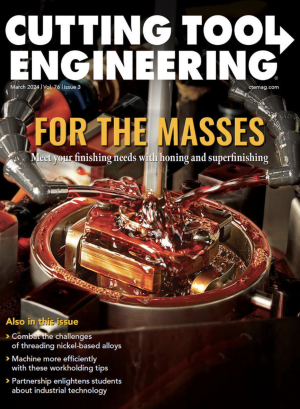Dear Doc: We cylindrical-traverse grind. There’s disagreement in the shop about whether to traverse off the workpiece and then downfeed, or to downfeed while still on the workpiece. What’s your take?
The Doc replies: I’m mostly a fan of downfeeding on the workpiece. Here’s why.
As you traverse-grind across the workpiece, you have two forces pushing up on the wheel: the grinding force and the coolant hydroplaning force. Those forces cause deflection. When you sparkout, that grinding force reduces to almost zero. But the coolant hydroplaning force doesn’t reduce. It’s still causing deflection. That hydroplaning force isn’t small, and so the deflection isn’t small.
Let’s say that your coolant is causing 5 µm (0.0002") of deflection. When the wheel traverses off the workpiece, that deflection goes from 5 µm to 4 µm to 3 µm to 2 µm to 1 µm to 0 µm. Now you’ve got a 5 µm taper on the end of your workpiece. And sparkout isn’t going to fix that taper.
If you traverse only, say, 1 mm of your 50-mm-wide wheel off the workpiece, you’re not going to get that taper. This is especially true in cylindrical-ID grinding, where spindles are notoriously unstiff.
Be careful. When you downfeed while still on the workpiece, what are you doing? You’re cylindrical-plunge grinding. I’ll often ask operators: “What is your downfeed speed?” They reply: “ten microns.” I say: “That’s the downfeed, not the downfeed speed. What’s the downfeed speed?” Often, they don’t know. It’s buried somewhere in the G-code. If the wheel just drops that 10 µm, you’re crashing into your workpiece. And that means high wheel wear, burn, etc. Ease into the workpiece, just like in cylindrical-plunge grinding.
Dear Doc: An old-timer grinder at our shop used to say: “1,000 surface feet per minute equals one wheel grade.” He’s now long gone. What did he mean?
The Doc replies: The rule of thumb was this: For every 1,000 sfpm (5 m/s) you increase your wheel speed, your wheel acts one grade harder. So, an H-grade wheel running at 50 m/s acts like an I-grade wheel running at 45 m/s, which acts like a J-grade wheel running at 40 m/s, which acts like a K-grade wheel running at 35 m/s.
And it’s true. Mostly. Sort of. Some of the time. With caveats.
Why is this? Because as you increase your wheel speed, your Grit Penetration Depth (or, if you prefer, chip thickness) gets smaller, which means smaller forces on the grits, which means less wheel wear. So, your wheel “acts harder.”
But here are the caveats: That faster wheel speed also means more heat generation and faster grit dulling. So, using the rule of thumb that 1,000 sfpm equals one wheel grade harder is fine in the short term. I don’t like it as a long-term strategy. If you need a harder grade wheel, order a harder grade wheel.
Dear Doc: My grinding career is winding down, and before I retire I’d like to contribute to the world’s grinding knowledge by writing one academic paper. I have tons of data. Which are the best journals for grinding academic article? And how do I go about this?
The Doc replies: In my opinion, the three best are the International Journal of Machine Tools & Manufacture, the Journal of Materials Processing Technology, and the CIRP Annals. Second tier (but still very respectable) are the SME-NAMRC, ISAAT and CIRP Conferences (and others). Conferences are fun because they’re held in fun places like Tokyo, Stockholm, Budapest, Mumbai. And hopefully your boss pays for your airfare and hotel. Then you stay a few extra days.
How do you go about it? You collect data, process it, and then create a story around it that advances our understanding of grinding. It has to be novel. This is the tricky part. I have assisted many people with this aspect. You have to know what the academic literature already says, and what could be new.
Related Glossary Terms
- coolant
coolant
Fluid that reduces temperature buildup at the tool/workpiece interface during machining. Normally takes the form of a liquid such as soluble or chemical mixtures (semisynthetic, synthetic) but can be pressurized air or other gas. Because of water’s ability to absorb great quantities of heat, it is widely used as a coolant and vehicle for various cutting compounds, with the water-to-compound ratio varying with the machining task. See cutting fluid; semisynthetic cutting fluid; soluble-oil cutting fluid; synthetic cutting fluid.
- grinding
grinding
Machining operation in which material is removed from the workpiece by a powered abrasive wheel, stone, belt, paste, sheet, compound, slurry, etc. Takes various forms: surface grinding (creates flat and/or squared surfaces); cylindrical grinding (for external cylindrical and tapered shapes, fillets, undercuts, etc.); centerless grinding; chamfering; thread and form grinding; tool and cutter grinding; offhand grinding; lapping and polishing (grinding with extremely fine grits to create ultrasmooth surfaces); honing; and disc grinding.


